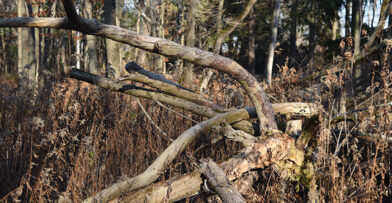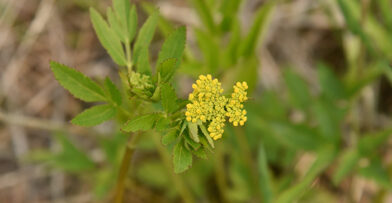When you hike the Center’s Lake Terrace Loop, you might notice some changes to the plant populations. There are many species of native plants growing and you will see new bursts of color. It’s because the Center’s terrace has been the focus of an effort to remove the invasive species and restore native plants.
Assessing Invasive Species
In 2014, Marc White, our then Director of Conservation, performed an ecological assessment at the terrace. It was apparent that the dominant species were the invasive plants Dame’s Rocket and Garlic Mustard. Fortunately, there were native species persisting in the ground layer as well. So Marc created a conservation plan for the terrace, which included eradicating the invasive plants while preserving the native ones, helping us to achieve our conservation goals of increasing both biotic diversity and ecosystem function on the terrace.
Attempting to control the invasive plants by hand pulling would be labor intensive, so the Center instituted a new practice beginning in 2015: mowing. This involves using a brush cutter with three blades, like a weed wacker but with more power, to cut away the invasive species. There is a strategy to mowing, and it revolves around timing. The Resource Ecologists and interns mow the terrace while the plants are flowering, but before they seed. This way, they are able to prevent more plants from growing. It’s a tricky balance, because if they mow too early, they may need to mow again to cut down plants that developed after they went through. Mow too late, and there’s a good chance seeds are dropped.
For the last several years, the ecologists and interns mowed the area for six to seven hours a day over the course of six weeks in May and early June. It’s a lot of work, but it has paid off. This year, when they looked at the land, they realized they didn’t have to mow. Their efforts had produced results that allowed them to hand pull the invasive plants.
Results of the New Strategy
Nature is always changing. This year the conservation team saw incredible results: Garlic Mustard didn’t flower and there was no seed production. A small army of volunteers concentrated efforts on hand pulling Dame’s Rocket, but next year they expect a bumper crop of Garlic Mustard, Marc said. It’s because of their life cycle. Garlic Mustard is a biennial, which means it dies after producing seed in its second year. The Center’s conservation team had succeeded in taming the odd-year flowering population of Garlic Mustard. Mowing will need to happen in 2020 to tame Garlic Mustard for the even year’s population. In 2022, volunteers should be able to hand pull it again.
New Arrivals
There is more exciting news about the terrace: the appearance of previously absent native species. This year, the conservation team noted Wild Bergamot, Wild Strawberry, Joe Pye Weed, Stick Seed, Great Waterleaf, Jack in the Pulpit, and others. These are plants one would expect to see in healthy habitats, so their arrival is encouraging.
Unexpectedly, two new invasive plants have also shown up on the terrace, so the conservation team will adjust their strategy to deal with them. Brittlestem Hempnettle and Creeping Bell Flower are a new part of the mix of invasive plants. The annual mowing on the terrace allowed new plants to spread, including these undesirable ones.
The goal is to reach a point where the conservation team is directing resources to seeding, and planting trees, shrubs, and other native plants. But as one doesn’t always know what the future will bring, they rely on a system of early detection and rapid response. This way, when unexpected events arise, they are ready to handle them and still maintain momentum toward restoration. Head down to the terrace to see the new plant species and the progress our conservation team has made in restoring this area of Schlitz Audubon.


